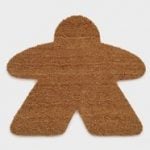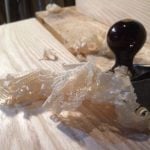Couple of plane setup/restoration questions
Welcome! / Forums / General Woodworking Discussions / Tools and Tool Maintenance/Restoration / Couple of plane setup/restoration questions
- This topic has 8 replies, 7 voices, and was last updated 7 years, 3 months ago by
 Sandy.
Sandy.
-
AuthorPosts
-

I found an old Stanley no 4 on ebay for a reasonable price, and have been following Paul’s guide to getting it up and running.
There are a few things I’m struggling with a bit though:
1. The depth adjustment wheel on the back is pretty loose, and turns very easily. Most planes I’ve tried before have had this much tighter, and I’m not sure how to adjust this, or what the ideal setting should be.
2. When setting up the plane for use, I always have to push the lateral adjustment lever a long way to one side to get an even cut. Does this mean that some part of the plane or blade isn’t quite square/straight?
3. The blade itself is very bowed, if I lay it on a flat surface (bevel side down), there’s about a 4mm gap between the middle and the surface. I’ve spent several hours lapping the back (only lapping around 20mm or so closest to the cutting edge), but it’s taking a huge amount of time to get a polished surface all the way to the cutting edge. Could it be because the blade is too bowed? Should I stick with it or look for a replacement blade?
Any advice would be welcome.

Hi,
1. Try tightening up the screw under the lever cap.
2. Check the alignment of everything before you lock down the lever cap
3. Put the blade down on a flat surface and hit the lump (curve side up) with a hammer. Check for straightness and repeat.
Hope that helps
Darren.

1. may or may not be an issue. It should turn freely as that is what it is meant to do – travel along the threads to achieve the chosen depth setting and remain adjustable. Once the plane is set to depth i can easily adjust back or forwards to change the setting to suit the cut I need.
2. My #4 always leans to one side in order to get blade protruding even. It may be a frog alignment issue (but I don’t think so in my case), but I have always been able to just leave it to one side and as long as you can get even shavings as Paul demonstrates once set properly, I have never had an issue in getting a shaving.
3.probably your easiest is to get a new blade. Depends if you are just eager to get producing shavings, or if you want to take the time to refurbish your existing.
Good luck – hope that helps.1. This is common and nothing more than a minor nuisance. Just make sure that when you adjust the blade depth that your final adjustment moves the iron outward rather than inward.
2. Make sure that the frog is screwed down straight. If so, the edge of the iron may be out of square. If you can get an even cut by adjusting the lateral lever to one side it should work fine.
3. You don’t need to polish that far back. If you can get the first 10mm (3/8″) flat, that’s probably all that you will ever need. Odds are that you have some chips, pitting and/or heavy wear in the leading 2 or 3 mm. If so you could save yourself a lot of work by grinding the edge back far enough to eliminate that.
As for the bow: When you assemble the cap iron to the blade, put blade assembly and lever cap in place and tighten the lever cap, does the iron sit flat against the frog? If so you are good to go.
Dave

Thanks for all the tips. I tried striking the blade with a hammer to remove the bowing (I found Paul’s post on this as well), but it just sprang back every time.
It does seem to be usable though, as the cap iron seems to push it flat enough to get good shavings.
After some more examination, it also looks like the end of the blade was ground at a slight angle from the sides of the blade, so this might explain why it always needs adjusting in one direction to get an even cut. I guess I can straighten this by hand, but it seems like it would take a very long time… (so maybe a new blade is again the right option).
Thanks again for the help.


This is going to sound odd but you can turn the iron bow side down and strike it with a ball side of a ball peen hammer along the center of the iron with short tapping strokes. Do this on a anvil or a larger piece of steel for a backing. The idea is not to bend the iron but to stretch and expand the surface to force the outer edges, which in this case are sticking up, down. Try this on a piece of scrap metal to prove the concept and then wack away at it.
-
AuthorPosts
- You must be logged in to reply to this topic.
